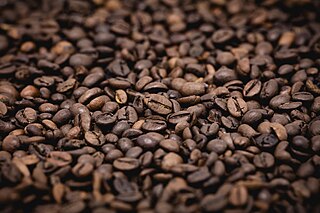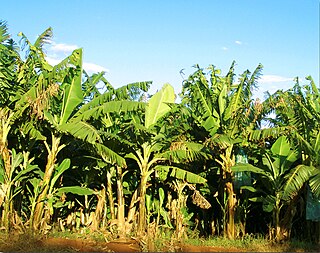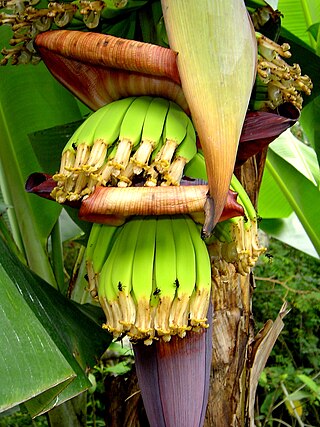
A banana is an elongated, edible fruit – botanically a berry – produced by several kinds of large herbaceous flowering plants in the genus Musa. In some countries, bananas used for cooking may be called "plantains", distinguishing them from dessert bananas. The fruit is variable in size, color, and firmness, but is usually elongated and curved, with soft flesh rich in starch covered with a rind, which may be green, yellow, red, purple, or brown when ripe. The fruits grow upward in clusters near the top of the plant. Almost all modern edible seedless (parthenocarp) bananas come from two wild species – Musa acuminata and Musa balbisiana. The scientific names of most cultivated bananas are Musa acuminata, Musa balbisiana, and Musa × paradisiaca for the hybrid Musa acuminata × M. balbisiana, depending on their genomic constitution. The old scientific name for this hybrid, Musa sapientum, is no longer used.

The United Fruit Company was an American multinational corporation that traded in tropical fruit grown on Latin American plantations and sold in the United States and Europe. The company was formed in 1899 from the merger of the Boston Fruit Company with Minor C. Keith's banana-trading enterprises. It flourished in the early and mid-20th century, and it came to control vast territories and transportation networks in Central America, the Caribbean coast of Colombia and the West Indies. Although it competed with the Standard Fruit Company for dominance in the international banana trade, it maintained a virtual monopoly in certain regions, some of which came to be called banana republics – such as Costa Rica, Honduras, and Guatemala.

A cash crop, also called profit crop, is an agricultural crop which is grown to sell for profit. It is typically purchased by parties separate from a farm. The term is used to differentiate marketed crops from staple crop in subsistence agriculture, which are those fed to the producer's own livestock or grown as food for the producer's family.

Chiquita Brands International S.à.r.l., formerly known as United Fruit Co., is a Swiss-domiciled American producer and distributor of bananas and other produce. The company operates under a number of subsidiary brand names, including the flagship Chiquita brand and Fresh Express salads. Chiquita is the leading distributor of bananas in the United States.

The Rainforest Alliance is an international non-governmental organization (NGO) with staff in more than 20 countries and operations in more than 70 countries. It was founded in 1987 by Daniel Katz, an American environmental activist, who serves as the chair of the board of directors. The NGO states that its mission is “to create a more sustainable world by using social and market forces to protect nature and improve the lives of farmers and forest communities.” Its work includes the provision of an environmental certification for sustainability in agriculture. In parallel to its certification program, the Rainforest Alliance develops and implements long-term conservation and community development programs in a number of critically important tropical landscapes where commodity production threatens ecosystem health and the well-being of rural communities.

Fyffes plc is a fruit and fresh produce company. The Fyffes brand is most closely associated with the banana industry, although it is applied to a wide range of fruits and fresh produce, including the Fyffes Gold Pineapples, and Fyffes melons.

Coffee is a popular beverage and an important commodity. Tens of millions of small producers in developing countries make their living growing coffee. Over 2.25 billion cups of coffee are consumed in the world daily. Over 90 percent of coffee production takes place in developing countries — mainly South America — while consumption happens primarily in industrialized economies. There are 25 million small producers who rely on coffee for a living worldwide. In Brazil, where almost a third of the world's coffee is produced, over five million people are employed in the cultivation and harvesting of over three billion coffee plants; it is a more labor-intensive culture than alternative cultures of the same regions, such as sugar cane or cattle, as its cultivation is not automated, requiring frequent human attention.

Agriculture in Colombia refers to all agricultural activities, essential to food, feed, and fiber production, including all techniques for raising and processing livestock within the Republic of Colombia. Plant cultivation and livestock production have continuously abandoned subsistence agricultural practices in favour of technological farming resulting in cash crops which contribute to the economy of Colombia. The Colombian agricultural production has significant gaps in domestic and/or international human and animal sustenance needs.

Agriculture in Indonesia is one of the key sectors within the Indonesian economy. In the last 50 years, the sector's share in national gross domestic product has decreased considerably, due to the rise of industrialisation and service sector. Nevertheless, for the majority of Indonesian households, farming and plantation remains as a vital income generator. In 2013, the agricultural sector contributed 14.43% to national GDP, a slight decline from 2003's contribution which was 15.19%. In 2012, the agricultural sector provides jobs to approximately 49 million Indonesians, representing 41% of the country's total labor force.

Banana production in Honduras plays an important role in the economy of Honduras. In 1992, the revenue generated from banana sales amounted to US$287 million and along with the coffee industry accounted for some 50% of exports. Honduras produced 861,000 tons of bananas in 1999. The two corporations, Chiquita Brands International and the Dole Food Company are responsible for most Honduran banana production and exports.

A banana plantation is a commercial agricultural facility found in tropical climates where bananas are grown.

Banana production in Brazil accounts for approximately 10% of the entire world banana production, making Brazil a major banana-producing country in the world. Production has steadily increased over the years, rising from 5.4 million tonnes in 1997 to almost 7 million tonnes in 2007. In 2000, Brazil was fourth, behind India, Uganda and Ecuador, in banana production. By 2006, Brazil became the second largest banana-producer, behind only India, followed by China, Ecuador and the Philippines. Most of the bananas produced are consumed domestically. Gross exports has increased from 12.5 thousand tonnes in 1995 to more than 220 thousand tonnes in 2002 and 2003, mostly to neighbours Argentina and Uruguay, but these figures are still far behind industry leaders such as Ecuador, Costa Rica, the Philippines and Colombia which export more than a million tonnes of bananas annually.

The Grand Nain banana is a banana cultivar of Musa acuminata. It is one of the most commonly cultivated bananas and a member of the commercial Cavendish banana cultivar group. It is also known as the Chiquita banana because it is the main product of Chiquita Brands International.

Agriculture in the Democratic Republic of the Congo is an industry in the country of the Democratic Republic of the Congo that has plenty of potential.
While the production of bananas for export is largely in the hands of large commercial companies, such as Chiquita or Dole, the Caribbean, and particularly the Windward Islands, are notable for the production of bananas by small holders for export.
Costa Rican agriculture plays a profound part in the country's gross domestic product (GDP). It makes up about 6.5% of Costa Rica's GDP, and 14% of the labor force. Depending upon location and altitude, many regions differ in agricultural crops and techniques. The main exports include: bananas, pineapples, coffee, sugar, rice, vegetables, tropical fruits, ornamental plants, corn, potatoes and palm oil.
Tea is a major cash crop that is grown in Kenya. Kenyan tea has been the leading major foreign exchange earner for the country.
Fairtrade bananas was a marketing initiative which focused on increasing the price paid to small banana growers and the wages of agricultural workers. This is not a commercial brand, but a marketing strategy. Fair trade is based on higher prices paid by consumers that allow an equitable distribution of gains from trade over the chain partners.

Banana production in Ecuador is important to the national economy. Ecuador is one of the world's top banana producers, ranked 5th with an annual production of 8 million tonnes as of 2011. The country exports more than 4 million tonnes annually. The crop is mostly grown on private plantations which sell their crop to national and international companies such as Chiquita, Del Monte, Dole, and Noboa. and others.
The horticulture industry embraces the production, processing and shipping of and the market for fruits and vegetables. As such it is a sector of agribusiness and industrialized agriculture. Industrialized horticulture sometimes also includes the floriculture industry and production and trade of ornamental plants.















